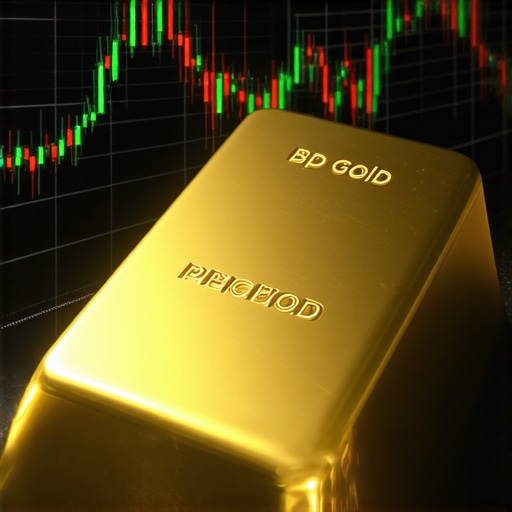Understanding Gold Price Trends: Key Insights for Investors
The gold market has long been a focal point for investors seeking to diversify their portfolios and hedge against inflation. As we look forward to 2025, it’s essential to understand the key trends that will influence gold prices and how investors can position themselves accordingly. This article explores the factors driving gold price fluctuations and offers insights into what investors should watch closely in the coming year.
Factors Influencing Gold Prices: Economic Indicators
One of the primary drivers of gold prices is economic indicators, including inflation rates, currency strength, and interest rates. When inflation rises, gold often becomes a safe haven as its value tends to maintain stability compared to fiat currencies. Additionally, in times of economic uncertainty, investors flock to gold, pushing its price upward. For instance, analyses of gold price forecasts for 2025 suggest that ongoing inflationary pressures could support higher gold prices as more investors seek refuge in tangible assets.
Geopolitical Factors: The Role of Global Events
Geopolitical tensions can also significantly impact gold prices. Factors such as trade disputes, military conflicts, and political instability drive investors to gold as a secure investment. For example, any escalation in global tensions or uncertainty surrounding major economies can lead to increased demand for gold. Monitoring news and global developments is crucial for investors who wish to anticipate price movements. Keeping an eye on gold demand trends will provide insights into how these geopolitical factors play out in the marketplace.
Technological Advancements in Gold Trading
With the rise of technology in financial markets, investors now have access to advanced trading platforms and tools that can enhance their trading strategies. Innovations such as artificial intelligence and machine learning are becoming prevalent in predicting market movements, including gold prices. Investors looking to optimize their trading must consider adopting these technologies to stay ahead of trends. Resources like gold trading techniques can provide valuable insights into how to leverage technology effectively.
Investment Vehicles: Gold ETFs and Mutual Funds
When contemplating gold investments, understanding the available vehicles is essential. Gold ETFs and mutual funds are popular choices among investors looking for exposure to gold without holding physical assets. These investment options provide liquidity and diversification, making them attractive for both new and seasoned investors. Evaluating the pros and cons of these options is vital for making informed decisions. For a deeper dive into this topic, consider reading evaluating options in gold ETFs and mutual funds.
As we continue to explore the dynamic landscape of gold prices, it’s important for investors to remain informed about the various factors influencing the market. By staying updated on economic indicators, geopolitical events, and investment options, investors can position themselves to navigate the gold market effectively.
Analyzing Gold Demand Trends: What Investors Must Know
Understanding gold demand dynamics is crucial for investors looking to capitalize on price movements. Factors such as industrial demand, jewelry consumption, and investment trends significantly influence gold prices. In 2025, the jewelry sector is expected to rebound, especially in emerging markets, which could lead to increased demand. Monitoring gold demand trends will provide investors with insights into anticipated market shifts.
Central Bank Purchases: A Driving Force
Central banks play a pivotal role in the gold market, often acting as substantial buyers to diversify their reserves. In recent years, many central banks have increased their gold holdings, which can drive prices higher. Investors should keep an eye on reports regarding central bank gold purchases, as these can signal confidence in gold as a long-term asset. The implications of these purchases often ripple through the market, affecting individual investors.
Global Economic Recovery and Gold Prices
The pace of global economic recovery post-pandemic will also impact gold prices. As economies stabilize, the demand for gold may shift. For example, a robust recovery could lead to increased interest rates, which typically depresses gold prices. Conversely, a sluggish recovery may keep gold prices buoyant as investors seek safe-haven assets. Staying informed about gold price forecasts will help investors anticipate these changes.
Technological Innovations Impacting the Gold Market
Technological advancements are transforming how gold is mined, traded, and invested in. Innovations in mining technology can enhance efficiency, potentially lowering production costs and impacting supply. Additionally, the rise of digital gold platforms is making it easier for investors to buy and sell gold. These platforms are democratizing access to gold investments, particularly for younger investors. Exploring gold stocks and how these technologies affect the market is essential for adapting to new investment landscapes.
The Role of Gold in a Diversified Portfolio
Investors should also consider the strategic role gold plays in portfolio diversification. Gold often behaves differently than stocks and bonds, providing a hedge against market volatility. As more investors recognize this, the demand for gold-related investments may increase. Understanding the role of gold in a diverse investment portfolio will equip investors with the knowledge to make informed decisions about their asset allocation.
As we move further into 2025, the interplay of these factors will shape the gold market. Investors need to remain vigilant and adaptable, ready to adjust their strategies based on evolving market conditions. This ongoing analysis of demand trends, technological advancements, and economic indicators will be critical in navigating the complexities of gold investing.
Investment Strategies for Gold: Maximizing Your Portfolio Returns
As investors assess their positions in the gold market, having effective investment strategies is crucial. Understanding the different methods of investing in gold can lead to more informed decisions and potentially greater returns. This section will explore various investment strategies, from direct purchases to advanced trading techniques.
Direct Gold Ownership: Physical Assets vs. Paper Gold
Investors often debate whether to invest in physical gold, such as bullion or coins, versus paper gold, like ETFs and futures contracts. Physical gold provides tangible ownership and can be a hedge against inflation. However, it requires secure storage and insurance, which can incur additional costs. On the other hand, paper gold offers liquidity and ease of trading. For those interested in physical investments, understanding how to buy gold bullion can be beneficial.
Gold ETFs: A Flexible Option for Investors
Gold Exchange-Traded Funds (ETFs) have gained popularity among investors seeking exposure to gold without the complexities of physical ownership. These funds track the price of gold and can be traded like stocks. They offer diversification and lower fees compared to mutual funds. Investors should evaluate how to create a balanced portfolio with gold ETFs to optimize their investments. Additionally, understanding the key features of gold ETFs can help in selecting the right fund for individual investment goals.
Gold Futures and Options: Advanced Trading Techniques
For those with a higher risk tolerance, gold futures and options present opportunities for profit in fluctuating markets. Futures contracts allow investors to buy or sell gold at a predetermined price, while options give the right but not the obligation to do so. These instruments can amplify returns but also entail significant risks. Investors should familiarize themselves with key gold trading techniques that can mitigate risks and enhance profitability.
Gold Mining Stocks: Investing in the Source of Gold
Another strategic approach is investing in gold mining stocks. These stocks often perform well when gold prices rise, as higher prices can lead to increased profits for mining companies. However, they also carry unique risks, including operational challenges and management decisions. Investors can explore insights into the best gold mining stocks for 2025 to identify promising investment opportunities in this sector. Diversifying between gold mining stocks and physical gold can create a balanced investment approach.
Long-Term vs. Short-Term Investment Strategies
Deciding on a long-term versus short-term investment strategy is essential. Long-term investors often focus on accumulating assets during market dips, while short-term traders may capitalize on price volatility. Understanding gold price forecasts can aid investors in determining the best times to enter and exit the market. Additionally, employing technical analysis can enhance short-term trading strategies, helping to identify trends and trading signals.
As the gold market continues to evolve, staying informed about various investment strategies is critical for maximizing returns. The interplay of market dynamics, technological advancements, and global economic conditions will shape future investment opportunities. For investors looking to deepen their understanding, exploring top gold investment strategies can provide valuable insights into optimizing their portfolios.
Maximizing Returns with Gold Investment Strategies
As investors delve deeper into gold markets, understanding effective investment strategies is crucial for maximizing returns. With the dynamics of the gold market constantly evolving, a well-informed approach can significantly enhance investment outcomes. This section will outline key investment strategies, including gold trading techniques, that can help investors optimize their portfolios.
Understanding Market Timing: When to Invest in Gold
Market timing is a critical factor in gold investment strategies. Successful investors often keep a close watch on market trends and economic indicators to identify optimal entry and exit points. For instance, the relationship between gold price forecasts and market conditions can provide insights into the best times to purchase gold. By analyzing data on inflation, interest rates, and geopolitical tensions, investors can make more informed decisions about when to buy or sell.
Diversification: Combining Gold with Other Assets
Another effective strategy is diversification. By combining gold with other asset classes, such as stocks and bonds, investors can mitigate risk while enhancing their potential for returns. Gold often acts as a hedge against market volatility, making it an excellent component of a diversified portfolio. To understand more about how gold fits within a broader investment strategy, refer to the role of gold in a diverse investment portfolio.
Leveraging Technology in Gold Investments
In today’s digital age, leveraging technology can significantly improve gold investment strategies. Online trading platforms and advanced analytics tools enable investors to execute trades efficiently and analyze market trends in real-time. For instance, utilizing trading algorithms can help optimize buying and selling decisions based on market data. Investors looking to refine their trading techniques should explore evaluating options in gold ETFs and mutual funds for more insights on technology-driven strategies.
Gold as a Long-Term Investment: Strategic Considerations
For many investors, gold is not just a short-term play but a long-term investment. Understanding the long-term trends in the gold market can help investors make strategic decisions. Factors such as inflation and currency fluctuations play a significant role in gold’s long-term value. Keeping an eye on 2025 gold market analysis will provide valuable insights into the potential long-term performance of gold investments.
Staying Informed: Continuous Learning for Investors
Finally, staying informed about market trends, economic developments, and new investment opportunities is essential for successful gold investing. Engaging with educational resources, such as articles and market analysis, can significantly enhance an investor’s understanding of the gold market. For deeper insights, consider exploring understanding gold price forecasts, which can equip you with the knowledge needed to navigate the complexities of gold investments.
In conclusion, effective gold investment strategies involve a blend of market timing, diversification, technological leverage, and continuous learning. By applying these principles, investors can position themselves to maximize returns and navigate the shifting landscape of gold markets in 2025 and beyond.
Frequently Asked Questions About Gold Investment
What factors influence gold prices?
Gold prices are influenced by several factors, including economic indicators such as inflation rates, interest rates, and currency strength. Geopolitical events and central bank policies also play a critical role, as they can drive demand for gold as a safe-haven asset.
Is investing in gold a good strategy for diversification?
Yes, investing in gold is considered a sound diversification strategy. Gold often behaves differently than stocks and bonds, providing a hedge against market volatility. Including gold in a portfolio can help balance risk and enhance potential returns.
How can I invest in gold?
Investors can invest in gold through various methods, including purchasing physical gold (bullion or coins), investing in gold exchange-traded funds (ETFs), trading gold futures and options, or buying shares of gold mining companies. Each method has its own risk profile and benefits.
What are the benefits of gold ETFs?
Gold ETFs offer several benefits, including liquidity, diversification, and lower management fees compared to mutual funds. They allow investors to gain exposure to gold prices without the need to store physical gold, making them a convenient investment option.
What are gold mining stocks?
Gold mining stocks are shares in companies that extract gold. These stocks can provide exposure to gold price movements while offering the potential for dividends and capital appreciation. However, they also carry risks associated with operational performance and management decisions.
How do geopolitical events affect gold prices?
Geopolitical events, such as trade disputes or military conflicts, often lead to increased uncertainty in financial markets. During such times, investors tend to flock to gold as a safe haven, driving up its prices. Understanding current events is crucial for predicting gold price movements.
What are the risks of investing in gold?
Investing in gold carries risks, including price volatility and market fluctuations. Additionally, physical gold requires secure storage and insurance, while gold mining stocks are subject to operational risks. Investors should carefully evaluate their risk tolerance before investing.
How can I stay informed about gold market trends?
Staying informed about gold market trends can be achieved by following reputable financial news sources, engaging with investment analysis platforms, and subscribing to newsletters focused on precious metals. These resources can provide valuable insights and updates on market developments.
What is the long-term outlook for gold prices?
The long-term outlook for gold prices is influenced by various factors, including economic conditions, inflation rates, and central bank policies. While predictions can vary, many analysts believe that gold will continue to hold its value as a hedge against inflation and economic uncertainty.
How can I create a gold investment strategy?
A gold investment strategy should consider factors such as your investment goals, risk tolerance, and market conditions. It may involve a mix of physical gold, gold ETFs, and mining stocks, tailored to your financial objectives and market outlook.
Authority Resources for Gold Investment Information
To enhance your understanding of gold investing, consider exploring the following trusted resources:
- World Gold Council – Provides comprehensive reports and insights on gold demand, supply, and investment trends.
- Investopedia – Offers educational articles on gold investing, market analysis, and trading strategies.
- Kitco – A leading source for news and information on precious metals, including real-time gold prices and market analyses.
- Bloomberg – Provides financial news and data, including insights on gold markets and economic indicators affecting prices.
- MarketWatch – Offers up-to-date news on financial markets, including gold prices and investment strategies.
Engaging with these resources will help you stay informed and develop a deeper understanding of the gold market and investment strategies.
Conclusion
As we wrap up our exploration of gold investment strategies and trends, it’s clear that understanding the dynamics of the gold market is crucial for investors. By considering factors such as economic indicators, geopolitical events, and various investment vehicles, you can make informed decisions to maximize your returns. Whether you choose to invest in physical gold, ETFs, or mining stocks, a well-rounded strategy that incorporates these elements will help you navigate the complexities of gold investing. As we look toward 2025 and beyond, staying informed and adaptable will be key to successfully capitalizing on the opportunities within the gold market.











The article provides a comprehensive overview of the multifaceted factors influencing gold prices as we head into 2025. I find the discussion on economic indicators particularly insightful. Inflation and interest rates have always impacted gold’s appeal, but with the current global economic uncertainties, gold’s role as a safe haven seems more pronounced than ever. From my experience, monitoring central bank purchases is crucial. These large-scale acquisitions often signal confidence in gold’s long-term stability, and as the article mentions, they ripple through the market, often preceding price shifts.
What stood out to me was the emphasis on technological advancements in gold trading. The rise of AI and machine learning isn’t just limited to stocks or forex but is increasingly shaping precious metals trading strategies. I’m curious about how accessible these advanced tools are to everyday investors and whether adopting them significantly improves portfolio outcomes in gold investment.
For those diversifying their portfolio, balancing physical gold, ETFs, and mining stocks seems wise, but it certainly requires ongoing vigilance and knowledge. How do other investors here balance these different vehicles, especially given the differing liquidity and risk profiles? It would be great to hear your strategies or insights on navigating these choices effectively in today’s market.
Great points, Margaret — I’d add a few pragmatic steps that helped me balance gold exposure without overcomplicating things. First, decide on a target allocation (many advisors suggest 5–15% of portfolio for gold as a hedge). Within that slice I personally split roughly: 50% gold ETFs for liquidity and low fees, 30% physical (small bullion/coins I can hold or store professionally) for long-term inflation protection, and 20% in selective mining stocks or royalty companies for upside — but I keep the mining portion small because of operational risk.
On AI and trading tools: retail access has improved a lot. Platforms like TradingView, some brokerages, and niche services offer ML-driven signals and backtesting. My advice is to treat those tools as decision-support, not autopilot: paper-test any algorithm, watch for overfitting, and start small. Also factor in storage, insurance, and tax implications when choosing physical vs paper gold.
Curious how others here size their gold allocation during times of rising inflation versus stable growth — do you shift the physical/paper mix?
This post offers a really comprehensive overview that highlights the importance of understanding market trends before diving in. I agree that economic indicators like inflation and interest rates are huge drivers, but I’ve noticed that geopolitical tensions tend to cause more immediate spikes in gold prices, especially when news breaks unexpectedly. In my own experience, staying alert to global news and central bank reports can help time entry points better. I’m particularly interested in how technological advances like AI are making their way into mainstream trading tools—do you think these are accessible enough for individual investors to leverage effectively, or are they still primarily for institutional traders? Also, for those balancing physical gold with ETFs, how do you manage the added costs and risks? I see so many options, and finding the right mix seems crucial for adapting to fast-changing conditions. It’d be great to hear what strategies others are finding success with, especially in periods of high volatility or economic uncertainty.